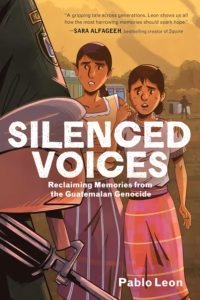Silenced Voices: Reclaiming Memories from the Guatemalan Genocide
Pablo Leon
HarperAlley
Published September 2, 2025
Amazon | Bookshop | Goodreads
About Silenced Voices
In this moving intergenerational tale perfect for fans of Messy Roots and Illegal, Eisner-nominated creator Pablo Leon combines historical research of the Dos Erres Massacre with his own experiences as a Guatemalan immigrant to depict a powerful story of family, sacrifice, survival, and hope.
Langley Park, Maryland, 2013.
Brothers Jose and Charlie know very little about the life their mother lived before she came to Maryland. In fact, Clara avoids even telling people she’s from Guatemala. So when Jose grows curious about the ongoing genocide trial of former military leader Efrain Rios Montt, at first the questions he asks Clara are shut down—he and Charlie were born here, after all, and there’s no reason to worry about places they haven’t been. But as the trial progresses, Clara begins to slowly open up to her sons about a time in her life that she’s left buried for years.
Dos Erres, Guatemala, 1982.
Sisters Clara and Elena hear about the civil war every day, but the violence somehow seems far away from their small village of Dos Erres, a Q’eqchi Maya community tucked away in the mountains of Guatemala. They spend their days thinking of other things—Clara, of gifts to bring her neighbors and how to perfect her mother’s recipes, and Elena, of rock music and her friend Ana, whose family had to flee to the US the year before. But the day the Kaibiles come to Dos Erres and destroy everything in their path, the sisters are separated as they flee through the mountains, leaving them to wonder…Have their paths diverged forever?
My Review
Kudos to authors like Pablo Leon who draw attention to important parts of recent history. The story begins in 2013 and shows the two brothers and their mother living in Maryland. As Jose becomes curious about his mother’s life in Guatemala and the Montt’s trial for genocide, we begin to see scenes from Clara and Elena’s lives as young women fleeing the violence.
The graphic panels keep the story moving, showing the characters’ emotional reactions and allowing readers to fill in some of what’s left unsaid about the terror and injustice they face. The story shifts between the past and present timeline smoothly. I didn’t find it confusing.
The author includes facts about Montt’s trial and the frustrating outcome. It also helps to add context to reasons people immigrate from places like Guatemala and how the U.S. involvement sometimes exacerbates instability in the region. Both the discussion about the real history and the context of these events when considering current issues like immigration are important. I love that this book offers this story inspired by real events as a graphic novel, making it very accessible to teen readers.
Content Notes
Recommended for Ages 14 up.
Profanity/Crude Language Content
None.
Romance/Sexual Content
None.
Spiritual Content
None.
Violent Content
References to genocide and warfare. Racist statements against indigenous people.
Drug Content
None.
Note: This post contains affiliate links, which do not cost you anything to use but help support this blog. I borrowed a copy of this book from the library. All opinions are my own.
